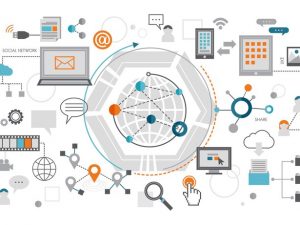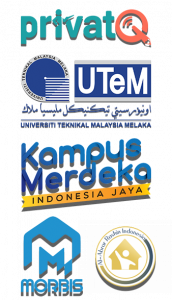INFORMATION TECHNOLOGY AND ITS DEVELOPMENT
Author; Nurohman

Hi buddy! In this article, Will explores the fascinating history of economic development, which can be divided into three very different eras. Starting from the time when it was hunters and gatherers, to the time when agriculture was the center of attention, and finally, the drastic change towards the industrial era with the revolutionary steam engine. Not only that, we will also see how today’s information technology has changed everything, bringing us to a new world of connection and opportunity. Let’s explore together the history of Information Technology and its extraordinary developments.
Information technology is changing things very quickly. Information technology, which is a combination of computer and communication technology, replaces the industrial paradigm with a post-industrial paradigm, which means it also changes business behavior or the business environment, which means that information systems technology creates closeness between business people and their customers, because it shortens distance and time so that the distance and time difference between consumer demand and the satisfaction of their needs is reduced. Such changes in the operating environment require changes in the form of management decision making, meaning that organizational structures with the presence of information technology require structures that develop and are updated quickly as a result of rapid change.
The history of economic development is divided into three eras, namely the agricultural era, the industrial era and the information era (Robert K. Elliot, 1992). Before 8000 BC, people lived by hunting, gathering and fishing, so they ate what they could and were nomadic. Then 10,000 years later, until 1650, the agricultural era began when agricultural land began to be settled and cultivated. In fact, since 1650, the industrial era began with the discovery of the steam engine which assisted human power in factories which converted raw materials into finished materials, the growth of cities where factories were located, and the expansion of industrial markets.
also read; Authentication Server as the Main Protector of Data Security
In 1955, the invention of the transistor and the installation of the first commercial computer (although the first computer used vacuum tubes connecting the computer to semiconductors) introduced the information age and Information Technology and Its Development. In the information era, the driving force of the system is not humans like in the agricultural era or machines in the industrial era, but information.
The bookkeeping system in this industrial era only dealt with material wealth or property, focused on products, bookkeeping was recorded as it occurred, and the organization was hierarchical. Third era accounting systems focus on changes in resources and processes. Because information managers must change organizational forms that facilitate the application of resources and processes. Also, the resources and responsibilities measured in third age information systems must change such that third age accounting systems must enable network forms of organization, i.e. a form of organization that allows its members to move quickly, grow and eventually disappear.
The resource that drives third age firms is knowledge, which is an asset, but also other assets, namely research and development, people, knowledge, data and innovation capacity. These assets are not reflected in the balance sheet for the second period. The third era accounting information system must provide real-time information about the company, so it does not wait for new transactions to occur and then record them. In practice, many companies use fully integrated manufacturing computers as a continuous process function. A great plus of this is that you can see the work items in the workshop (on the production floor) after a week or a month without manually counting the items and stopping all operations.
Information technology is needed in the third era so that the accounting system can function. With the help of information technology, third generation information technology companies and their developments can collect, analyze, report and disseminate new types of information: (Robert Elliott, 1992)
- Automatic data collection This is a huge advantage provided by information technology, design capabilities. user interfaces for customers, employees, and suppliers using automatically collected interaction data.
- Direct access and processing This is the advantage of the time dimension of information technology. Third era accounting systems must enable real-time analysis and response to market data. Data and analytics must be immediately available to the user or users.
- Geographical freedom This is the territorial dimension of the benefits of information technology. The third era accounting system must handle all aspects of the company
- ahaan, without forgetting remote areas, means managers can access information from every part of the company.
- Versatile analysis and reporting With the help of information technology, third generation accounting systems can perform new analyzes and reports in new formats as needed. Third generation corporate management information must be provided upon request, even if previous reports are not requested.
- Capacity for additional data types Information technology allows administrators to add new data to new data systems without redesigning the entire structure.
- Access to external databases With the help of information system technology, third generation accounting systems can open external databases. Most of the information required in third generation accounting systems relates to competitors and other market characteristics. Information also comes from public databases and must be managed according to management’s wishes.
Technology is necessary to build a triage accounting system, but it alone is not enough. The technology used in the system must be designed to serve the company’s needs, reflect the company’s management vision and strategy, and be an integral part of the company’s structure, style, and goals. Thus, technical capacity must be managed effectively to encourage changes in human behavior that use technology for profitable competition.
Information technology can cause changes in operating methods and changes in ways of thinking, for example, if previously it was often considered the main principle of optimal business operations, this can be demonstrated by changes in optimal principles, namely. The existence of information technology makes this principle questionable again, namely that optimization does not play an important role, but innovation is the key. Innovation after innovation is so fast that the optimization of one innovation is easily disrupted by the optimization of the next innovation, therefore, when new innovations develop rapidly, the principle of optimization is not a measure of a company’s success.
“For friends who want to learn more about the world of technology, you can stop by the best informatics study program at Alma Ata University, Yogyakarta”:
Reference
Andy Sutedjo, 2000, Investing in E-Commerce Business, Warta Ekonomi, No.41/TH.XI/ 28 February Info Financial, 2000, Lippo Life Doing Cyber Internet and E-Commerce Business, 16/XI/02 February.
Info Financial, 2000, Information Technology Increasingly Attracted by Investors, 16/XI/02 February.







![[Prestasi Mahasiswa Prodi Informatika Universitas Alma Ata]✨
Selamat dan Sukses kepada Tim P2MW "Go-Rent" Yang lolos mengikuti Program Pembinaan Mahasiswa Wirausaha (P2MW) Universitas Alma Ata.
#banggauaa #informatika
#p2mw #mahasiswa
#fakultaskomputerdanteknik](https://informatika.almaata.ac.id/wp-content/plugins/instagram-feed/img/placeholder.png)